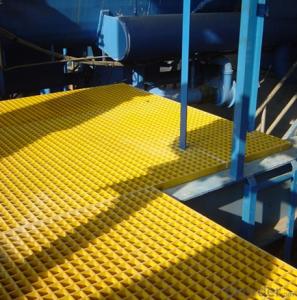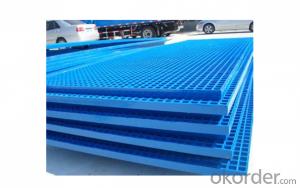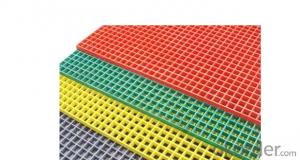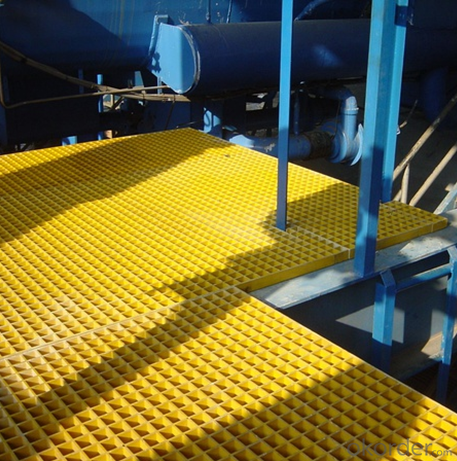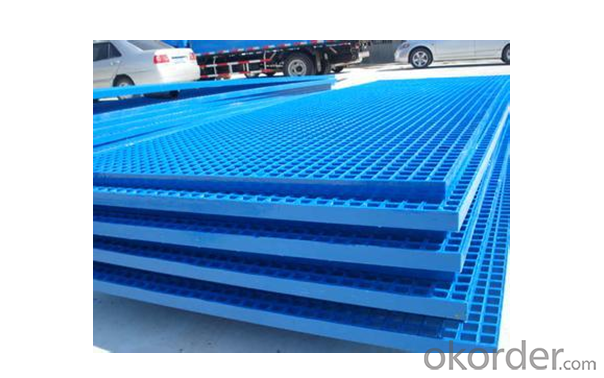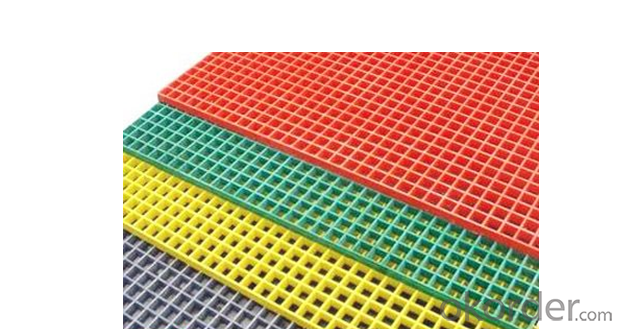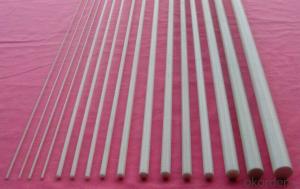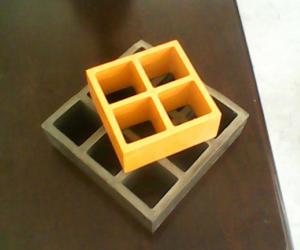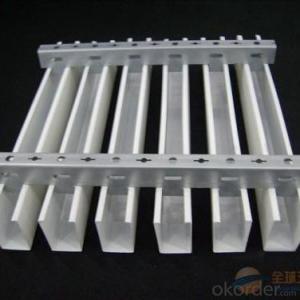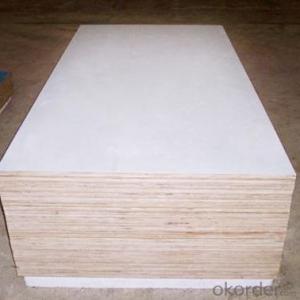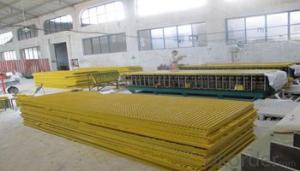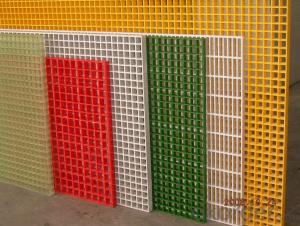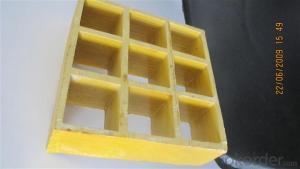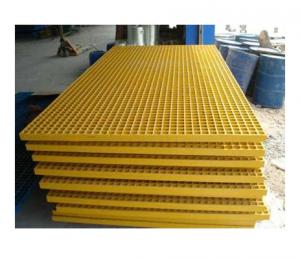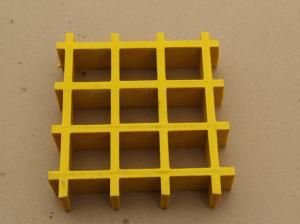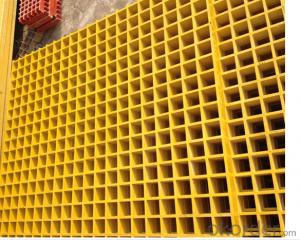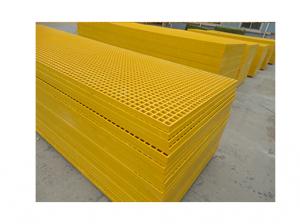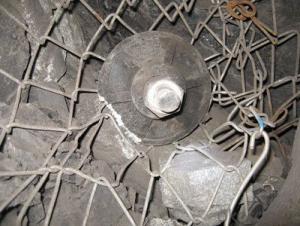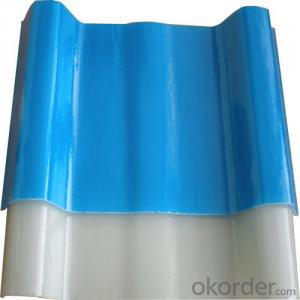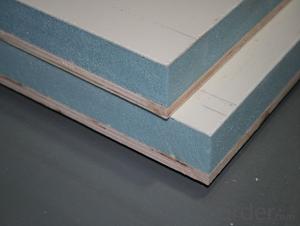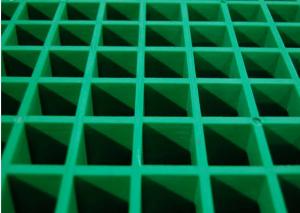Fiberglass FRP Phenolic Molded and Pultruded Grating with Best Quality
- Loading Port:
- China main port
- Payment Terms:
- TT OR LC
- Min Order Qty:
- 100 m²
- Supply Capability:
- 500000 m²/month
OKorder Service Pledge
OKorder Financial Service
You Might Also Like
Introduction
FRP Molded Grating is a structural panel which uses high-strength E-Glass roving as reinforcing material, thermosetting resin as matrix and then casted and formed in a special metal mold. It provides properties of light weight, high strength, corrosion resistance, fire resistance and anti-skid. FRP Molded Grating is widely used in oil industry, power engineering, water & waste water treatment, ocean survey as working floor, stair tread, trench cover, etc. and is an ideal loading frame for corrosion circumstances.
Feature
l Corrosion Resistance
l Fire Resistance
l Light Weight & High Strength
l Safety & Anti-slip
l Electrical Insulating
l Aging Resistance
Specification
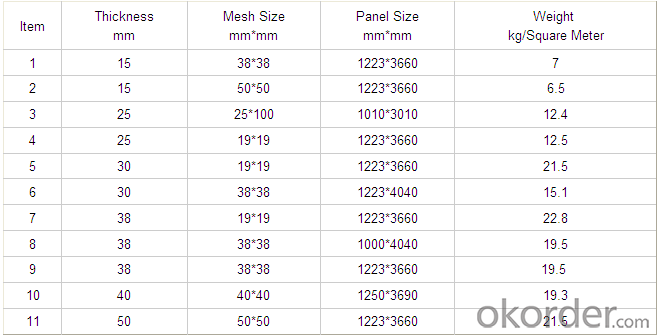
Advantage
1) coated with prevent aging layer
2) excellent insulating performance
3) no maintenance
4) high strength
5) long service life
6) easy installation
Application
l Power plants, substation equipment enclosures, antimagnetic, anti-static,to prevent small animals into the equipment failure, as there is electricity facilities and without power interval intervals.
l In high voltage electrical equipment for power line work, in order to prevent workers go wrong location, charged interval or near electrically charged equipment to dangerous distance.
l Pool railings in sewage treatment industry
l Corrosive chemical industry equipment around the fence
l All kinds of building maintenance section
FAQ
1. How about the documents after shipment?
After shipment, we ll send all original documents to you by DHL, including Packing List.Commercial Invoice, B/L, and other certificates as required by clients.
2. How long is the delivery time?
Usually it takes 10-25days after receipt of the deposits or L/C, and it also depends on the quantity of your order.
3. How's the payment?
Telegraphic Transfer(T/T) or Letter of Credit(L/C)
4. Do You Arrange Shipment?
Yes, dear esteemed customers, for FOB or CIF price, we will arrange shipment for you. For EXW price, clients need to arrange shipment by themselves or their agents.
5. How is the package?
Usually, we arrange the standard out-package for exporting.
PROCESS
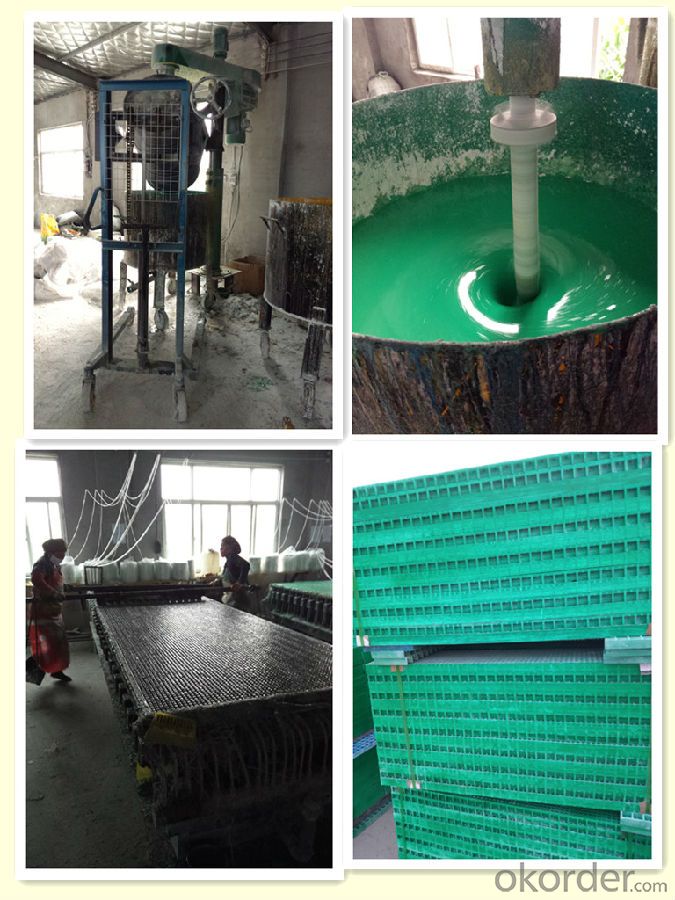
FACTORY
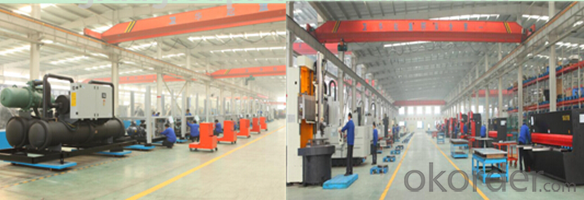
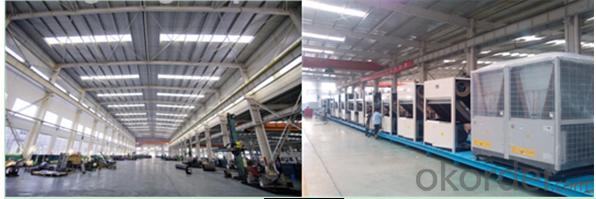
- Q: Can FRP pultrusion profiles be used in the production of electrical cabinets?
- Yes, FRP (Fiber Reinforced Polymer) pultrusion profiles can be used in the production of electrical cabinets. FRP pultrusion profiles provide excellent electrical insulation properties, high strength-to-weight ratio, and resistance to corrosion, making them suitable for use in electrical cabinets where electrical safety and durability are essential.
- Q: Are FRP pultrusion profiles resistant to automotive fluids?
- Yes, FRP pultrusion profiles are generally resistant to automotive fluids. The inherent chemical resistance and durability of the fiberglass-reinforced plastic make it suitable for withstanding exposure to various automotive fluids such as oils, fuels, and coolants. However, it is essential to consider the specific type of fluid and consult the manufacturer's guidelines to ensure the optimal performance and longevity of the FRP profiles in automotive applications.
- Q: Are FRP pultrusion profiles resistant to high-pressure gas?
- FRP pultrusion profiles are typically able to withstand high-pressure gas. They possess exceptional chemical resistance, making them commonly employed in situations involving exposure to different chemicals, including high-pressure gases. The ability of FRP pultrusion profiles to resist high-pressure gas relies on the specific resin and reinforcement employed during their fabrication. It is crucial to refer to the manufacturer's specifications and guidelines to guarantee that the chosen FRP profiles are appropriate for the intended application involving high-pressure gas.
- Q: The difference between polyurethane pultruded profiles and glass reinforced plastic profiles
- Compared with other materials, pultrusion with polyurethane can produce a variety of benefits. The utility model can improve the content of the glass fiber in the product and greatly improve the strength of the product. For example, pultruded window frames made of glass fiber and polyurethane resin, the strength of the resulting window frames is 8 times higher than that of the PVC window frames, and the conductivity is 40 times lower than that of aluminum. Therefore, the insulation performance is much better.
- Q: What is the dimensional stability of FRP pultrusion profiles?
- The dimensional stability of FRP (Fiber Reinforced Polymer) pultrusion profiles is generally very high. This is due to the unique structural characteristics of FRP materials and the pultrusion manufacturing process. FRP pultrusion profiles are made by pulling continuous fibers, such as glass or carbon, through a resin bath and then through a heated die. The resin is typically a thermosetting polymer, which means it undergoes a chemical reaction during the curing process to become a rigid and durable material. The pultrusion process ensures that the fibers are evenly distributed and aligned within the profile, resulting in a highly uniform and consistent material. This uniformity contributes to the dimensional stability of FRP pultrusion profiles. Furthermore, the thermosetting nature of the resin matrix provides excellent dimensional stability. Once the resin is cured, it retains its shape and dimensions even under varying temperature and humidity conditions. This makes FRP pultrusion profiles resistant to warping, shrinking, or expanding, which can occur in other materials like wood or metals. The high dimensional stability of FRP pultrusion profiles makes them ideal for a wide range of applications where precise and consistent dimensions are required. These profiles are commonly used in industries such as construction, infrastructure, transportation, and marine, where their ability to maintain their shape and dimensions over time is crucial for long-term performance and structural integrity.
- Q: Can FRP pultrusion profiles be used in protective barriers?
- FRP pultrusion profiles have the capability to be utilized in protective barriers. These profiles possess notable attributes such as a high strength-to-weight ratio, resistance to corrosion, and exceptional durability, which make them suitable for a wide array of applications, including protective barriers. They can be custom-designed and manufactured to meet specific requirements, such as impact resistance, load-bearing capacity, and fire resistance. Furthermore, FRP pultrusion profiles are highly malleable, allowing for easy molding into various shapes and sizes, thus providing flexibility in barrier design. Whether the purpose is to create noise barriers, security fences, or safety barriers, FRP pultrusion profiles offer a reliable and cost-effective solution for protective barriers across multiple industries.
- Q: Are FRP pultrusion profiles resistant to alkaline substances?
- FRP pultrusion profiles are known for their general resistance to alkaline substances. By using fiberglass reinforced polymer (FRP) in pultruded profiles, they acquire excellent resistance against a wide range of chemicals, including alkaline substances. The manufacturing process typically involves using a thermosetting polymer, such as polyester or vinyl ester, as the resin. This choice of resin ensures high resistance to alkaline solutions. Additionally, the fiberglass reinforcement adds strength and durability to the profiles, making them highly resistant to corrosion and degradation caused by alkaline substances. However, it is important to note that the specific resistance of FRP pultrusion profiles to alkaline substances may vary depending on the resin formulation and manufacturing process used. Therefore, it is advisable to consult the manufacturer or supplier to confirm that the profiles meet the specific resistance requirements for alkaline environments.
- Q: Can FRP pultrusion profiles be used in the construction of safety barriers?
- Indeed, FRP pultrusion profiles prove to be highly effective in the construction of safety barriers. When it comes to safety barrier applications, FRP pultrusion profiles surpass traditional materials like steel or concrete in numerous ways. To begin with, the strength and durability of FRP pultrusion profiles are remarkable. With their high tensile strength, these profiles can withstand substantial loads and impacts without deforming or breaking. Consequently, they are well-equipped to endure the forces that safety barriers may face, such as vehicular collisions or other accidents. Moreover, FRP pultrusion profiles possess a lightweight nature. When compared to steel or concrete, FRP is significantly lighter, which facilitates transportation, installation, and handling during construction. The reduced weight of FRP also proves advantageous in terms of ease of installation and cost-effectiveness. In addition, FRP pultrusion profiles boast excellent corrosion resistance. Unlike steel, FRP remains impervious to rust or corrosion, which can compromise the barrier's integrity and safety over time. This makes FRP particularly suitable for safety barriers exposed to outdoor environments or harsh weather conditions. Furthermore, FRP pultrusion profiles are non-conductive and non-magnetic, which presents advantages in certain safety barrier applications. For instance, in areas where electrical or magnetic interference poses a concern, such as near power lines or sensitive equipment, FRP barriers can provide an additional layer of safety by avoiding potential electrical or magnetic hazards. All in all, FRP pultrusion profiles offer a dependable and efficient solution for constructing safety barriers. Their strength, durability, lightweight nature, corrosion resistance, and non-conductive properties render them a suitable choice for a wide range of safety barrier applications.
- Q: Are FRP pultrusion profiles resistant to chemicals used in pharmaceutical manufacturing?
- Yes, FRP (Fiber Reinforced Plastic) pultrusion profiles are highly resistant to chemicals used in pharmaceutical manufacturing. FRP profiles are made by impregnating fibers with a resin matrix, typically polyester or vinyl ester, which provides excellent chemical resistance. These profiles are designed to withstand exposure to a wide range of chemicals including acids, alkalis, solvents, and various cleaning agents commonly used in pharmaceutical manufacturing processes. The combination of the fiber reinforcement and the chemical-resistant resin matrix makes FRP pultrusion profiles an ideal choice for applications where exposure to aggressive chemicals is a concern. Unlike traditional materials like steel or wood, FRP profiles do not corrode or react chemically with the substances they come into contact with. Furthermore, FRP pultrusion profiles offer several other advantages for pharmaceutical manufacturing applications. They have exceptional strength-to-weight ratio, are non-conductive, and have high mechanical resistance. Additionally, FRP is a non-porous material, preventing the absorption or release of chemicals, which is crucial for maintaining strict hygiene and avoiding contamination in pharmaceutical processes. Overall, FRP pultrusion profiles are a reliable and durable choice for pharmaceutical manufacturing environments, providing excellent resistance to the chemicals commonly used in these processes.
- Q: What are the different surface finishes available for FRP pultrusion profiles?
- There are several different surface finishes available for FRP (Fiber Reinforced Polymer) pultrusion profiles. These finishes are designed to enhance the aesthetics, durability, and functionality of the profiles. 1. Smooth Finish: This is the most basic surface finish option, where the profile has a smooth and glossy surface. It provides a clean and polished appearance, making it suitable for applications where a sleek and professional look is desired. 2. Textured Finish: Textured finishes add a tactile element to the profile surface, providing increased grip and slip resistance. This type of finish is commonly used in applications where enhanced traction is required, such as walkways, stairs, and ramps. 3. Anti-Skid Finish: Similar to textured finish, anti-skid finishes offer superior slip resistance. They are particularly suitable for areas exposed to wet or slippery conditions, such as marine environments, bridges, and industrial flooring. 4. UV Resistant Finish: FRP pultrusion profiles exposed to outdoor environments are often coated with a UV resistant finish. This type of finish protects the profiles from the damaging effects of sunlight, preventing color fading, degradation, and loss of mechanical properties. 5. Fire Retardant Finish: Fire retardant finishes are used to improve the fire resistance of FRP profiles. They are often required in applications where fire safety is a concern, such as building construction, transportation, and electrical enclosures. 6. Colored Finish: FRP pultrusion profiles can be manufactured with colored finishes to match specific design or branding requirements. This option allows for customization and visual integration with the surrounding environment. It is important to note that the availability of these surface finishes may vary depending on the manufacturer and specific product. Consulting with a FRP pultrusion specialist or supplier can provide more detailed information on the available finishes and their suitability for different applications.
Send your message to us
Fiberglass FRP Phenolic Molded and Pultruded Grating with Best Quality
- Loading Port:
- China main port
- Payment Terms:
- TT OR LC
- Min Order Qty:
- 100 m²
- Supply Capability:
- 500000 m²/month
OKorder Service Pledge
OKorder Financial Service
Similar products
Hot products
Hot Searches
Related keywords
